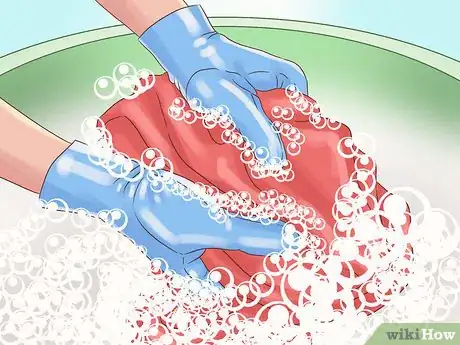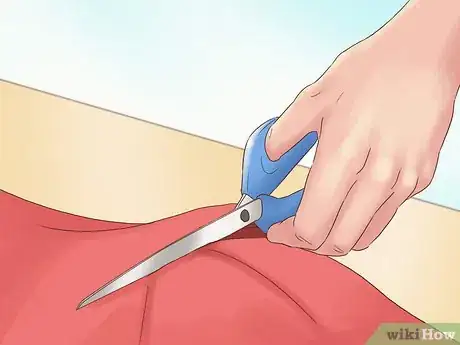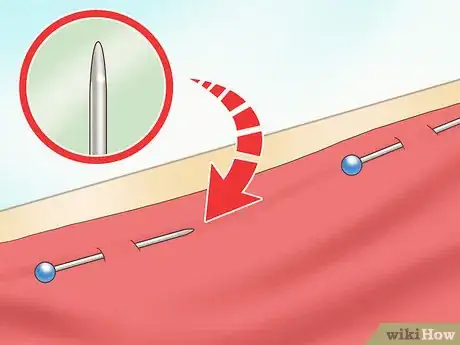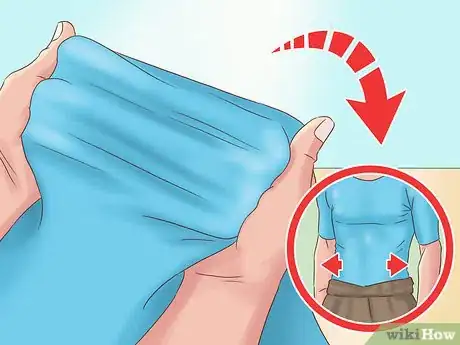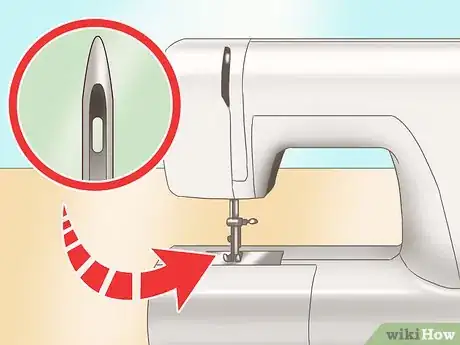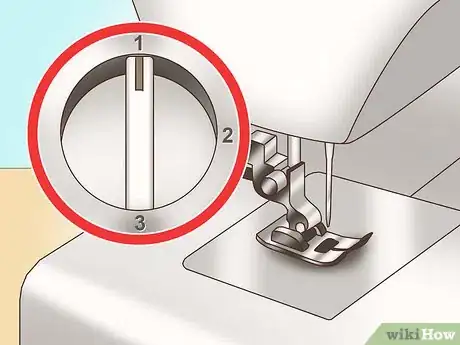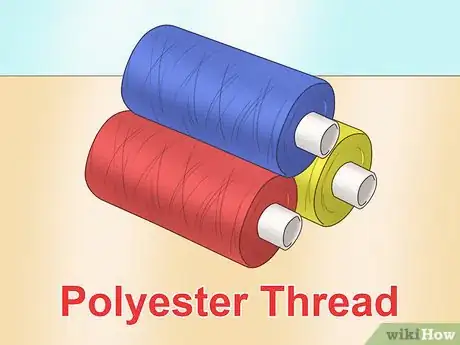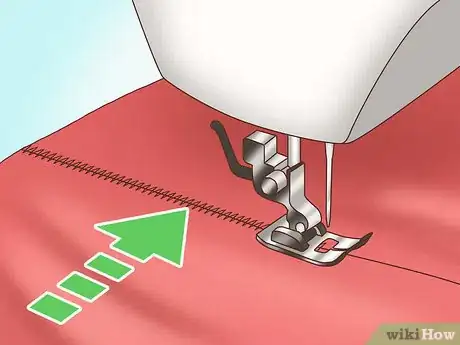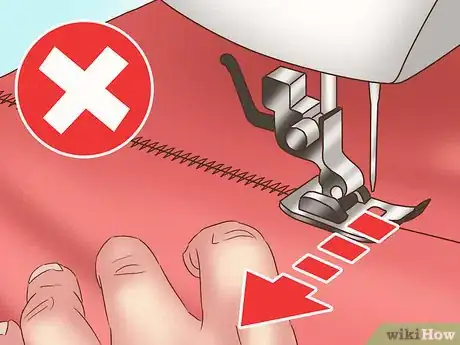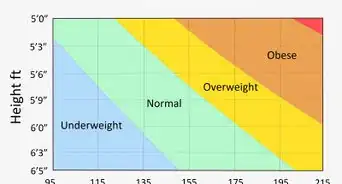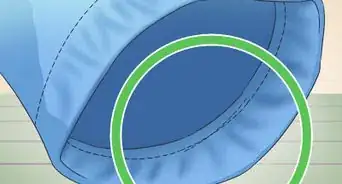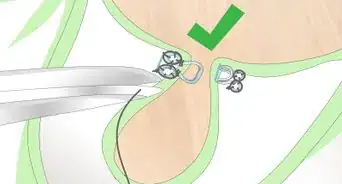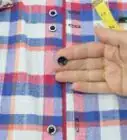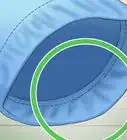This article was co-authored by Seleh Rahman. Seleh Rahman is a Tailor, Furrier, and the Owner of Seleh de Federal Hill in Baltimore, Maryland. With over 45 years of experience, Seleh specializes in fur, alterations, and fashion illustration. Seleh studied Fashion Design and Tailoring at Bay College of Maryland. He holds certifications in fur, design, and tailoring.
This article has been viewed 28,104 times.
Spandex can be a tricky material to work with. The material is stretchy, which makes it harder to sew. It is also easy to damage spandex when you sew with it. However, you can prepare the fabric by pre-washing it, using sharp scissors to cut it, and pinning it with ballpoint pins. You can also use light pressure on the presser foot, choose an all-purpose polyester thread, and set the sewing machine to a narrow zigzag stitch setting to get the best possible results when sewing spandex.
Steps
Preparing Spandex Fabric for Sewing
-
1Pre-wash the fabric. Depending on the other materials that spandex is blended with, it may shrink the first time you wash it. To prevent your finished garment from shrinking when you wash it, it is best to wash the fabric before you sew it. Check the instructions for your fabric because different blends of spandex require different types of washing and drying.[1]
- For example, if you are using a knit-spandex blend or a blend of spandex and microfiber, linen, or cotton, then you can wash the fabric with warm water and then dry it on low.
- For silk/spandex blends, hand wash the fabric with cool water and then hang it to air dry.
- For wool/spandex blends, take the fabric to the dry cleaners.
-
2Cut the fabric with sharp scissors or a rotary cutter. Spandex fabric can be difficult to cut and it is important to get straight edges. Make sure that you use a sharp pair of scissors or a sharp rotary cutter to cut out your pattern pieces for sewing.[2]
- If you are going to use a rotary cutter, then place the fabric on a cutting mat first. You can purchase cutting mats especially for cutting fabric at craft stores.
Advertisement -
3Pin with ballpoint pins to avoid damaging the fabric. Ballpoint pins have rounded tips so that they will not sever the threads in the fabrics you stick them through. Instead, the ballpoint pins slide in between the fibers. However, it is still a good idea to place the pins along the seam allowances. This way the holes will not be visible if you do end up damaging the fabric.[3]
-
4Make sure the stretchiest part of the fabric is going around the body. When pinning and sewing a garment with spandex, make sure that you position the stretchiest part of the fabric so that it is wrapping around the body.[4] Spandex fabric comes in 2 way and 4 way stretch. A 2 way stretch fabric will only stretch horizontally, but a 4 way stretch fabric will stretch horizontally and vertically. Before you sew with spandex, use your hands to tug at the fabric and find out which way it stretches.[5]
Sewing Spandex Fabric
-
1Install a ballpoint needle in your sewing machine. Regular needles may cut through the spandex fibers and result in damaged fabric. Ballpoint needles have rounded tips so they will go in between the fibers when you sew, so this type of needle is much less likely to damage your fabric.[6]
-
2Adjust the presser foot so that the pressure is set to 1. Too much pressure on the presser foot of your machine will pull on the fabric as you sew it. This can result in puckered areas along the seam. To reduce the chance of puckered stitches, reduce the pressure on the presser foot. Set your machine’s presser foot pressure to 1 before you begin sewing.[9]
- Check your sewing machine’s manual to find out how to change the presser foot pressure.
-
3Thread your machine with an all-purpose polyester thread. It is not necessary to use a special stretchy thread for spandex because you will be using a stitch setting that allows the fabric to stretch. However, all-purpose polyester thread has a bit of give to it, so it is a great choice for sewing spandex. Choose an all-purpose polyester thread in a color that matches your spandex fabric.[10]
-
4Set your machine to a narrow zigzag stitch. A narrow zigzag stitch works well for sewing spandex because it will provide slack that allows the spandex to stretch. Set your machine to the zigzag stitch and adjust the stitch length to 0.5 millimetres (0.020 in). If your fabric is a blend that is not too stretchy, then you may adjust the zigzag stitch to a longer length, such as 1.5 millimetres (0.059 in). However, it is important to keep the zigzag stitch within the range of 0.5 millimetres (0.020 in) to 1.5 millimetres (0.059 in) so that the seams will stretch with the fabric.[11]
- Check your sewing machine’s manual for instruction on how to change the stitch setting.
-
5Avoid pulling on the fabric as you sew it. With many fabrics, it is helpful to pull the fabric taut when you sew it. However, this strategy does not work with spandex because it can lead to puckering. When you are working with spandex fabric, do not pull on it. Don’t let the fabric hang over the edge of your work surface either because this will also pull on the fabric.[12]
Expert Q&A
-
QuestionWhat needle do you use to sew knit fabric?
 Seleh RahmanSeleh Rahman is a Tailor, Furrier, and the Owner of Seleh de Federal Hill in Baltimore, Maryland. With over 45 years of experience, Seleh specializes in fur, alterations, and fashion illustration. Seleh studied Fashion Design and Tailoring at Bay College of Maryland. He holds certifications in fur, design, and tailoring.
Seleh RahmanSeleh Rahman is a Tailor, Furrier, and the Owner of Seleh de Federal Hill in Baltimore, Maryland. With over 45 years of experience, Seleh specializes in fur, alterations, and fashion illustration. Seleh studied Fashion Design and Tailoring at Bay College of Maryland. He holds certifications in fur, design, and tailoring.
Professional Tailor & Furrier Use a number 14 or 16 needle. This is a thick needle that can get the job done without damaging the fabric or breaking the needle.
Use a number 14 or 16 needle. This is a thick needle that can get the job done without damaging the fabric or breaking the needle. -
QuestionIs spandex easy to sew?
 Seleh RahmanSeleh Rahman is a Tailor, Furrier, and the Owner of Seleh de Federal Hill in Baltimore, Maryland. With over 45 years of experience, Seleh specializes in fur, alterations, and fashion illustration. Seleh studied Fashion Design and Tailoring at Bay College of Maryland. He holds certifications in fur, design, and tailoring.
Seleh RahmanSeleh Rahman is a Tailor, Furrier, and the Owner of Seleh de Federal Hill in Baltimore, Maryland. With over 45 years of experience, Seleh specializes in fur, alterations, and fashion illustration. Seleh studied Fashion Design and Tailoring at Bay College of Maryland. He holds certifications in fur, design, and tailoring.
Professional Tailor & Furrier No, it's actually a bit of a pain. Spandex will absolutely ruin some needles and it can be difficult to keep a stitch consistent and even.
No, it's actually a bit of a pain. Spandex will absolutely ruin some needles and it can be difficult to keep a stitch consistent and even. -
QuestionWhat if I use a smaller ballpoint needle with Spandex?
 Seleh RahmanSeleh Rahman is a Tailor, Furrier, and the Owner of Seleh de Federal Hill in Baltimore, Maryland. With over 45 years of experience, Seleh specializes in fur, alterations, and fashion illustration. Seleh studied Fashion Design and Tailoring at Bay College of Maryland. He holds certifications in fur, design, and tailoring.
Seleh RahmanSeleh Rahman is a Tailor, Furrier, and the Owner of Seleh de Federal Hill in Baltimore, Maryland. With over 45 years of experience, Seleh specializes in fur, alterations, and fashion illustration. Seleh studied Fashion Design and Tailoring at Bay College of Maryland. He holds certifications in fur, design, and tailoring.
Professional Tailor & Furrier You're not going to have a super clean finish with a smaller, thinner needle. The thinner, more flexible the needle is, the more unforgiving Spandex will be.
You're not going to have a super clean finish with a smaller, thinner needle. The thinner, more flexible the needle is, the more unforgiving Spandex will be.
References
- ↑ http://www.threadsmagazine.com/2009/01/14/sewing-lycra-blends
- ↑ http://www.threadsmagazine.com/2009/01/14/sewing-lycra-blends
- ↑ https://www.seamwork.com/issues/2015/06/knits-without-a-serger
- ↑ http://www.threadsmagazine.com/2009/01/14/sewing-lycra-blends
- ↑ http://www.madeeveryday.com/2013/01/sewing-with-spandex-for-the-little-gymnast.html/
- ↑ https://www.seamwork.com/issues/2015/06/knits-without-a-serger
- ↑ Seleh Rahman. Professional Tailor & Furrier. Expert Interview. 25 June 2021.
- ↑ Seleh Rahman. Professional Tailor & Furrier. Expert Interview. 25 June 2021.
- ↑ https://www.seamwork.com/issues/2015/06/knits-without-a-serger
